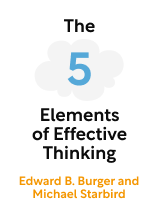

This article is an excerpt from the Shortform book guide to "The 5 Elements of Effective Thinking" by Edward B. Burger and Michael Starbird. Shortform has the world's best summaries and analyses of books you should be reading.
Like this article? Sign up for a free trial here.
How can the natural elements—earth, fire, air, and water—help you understand the process of effective thinking? How can you use this in your life in a practical way?
In The 5 Elements of Effective Thinking, Edward B. Burger and Michael Starbird explain that thinking is the source of all improvement and achievement. They describe the processes involved in thinking effectively and how this type of thinking can improve your life in the classroom, in the workplace, and in life in general.
Continue reading to discover how you can maximize improvement and achievement by learning to think effectively.
The 5 Elements of Effective Thinking
Burger and Starbird are renowned mathematicians and college professors as well as award-winning authors and educators. Together, they have written two other books about the application of mathematics in thinking and humor, The Heart of Mathematics: An Invitation to Effective Thinking and Coincidences, Chaos, and All That Math Jazz.
In The 5 Elements of Effective Thinking, Burger and Starbird break down the process of effective thinking into elements aligned with the natural elements identified by the ancient Greeks: earth, fire, air, and water. The authors then add a fifth element to sum up the results of the previous four: change.
- Earth represents the establishment of a firm foundation of ideas.
- Fire represents the embracing of failure as a learning tool.
- Air represents the constant questioning of what you know and what you’re learning.
- Water represents the progression of ideas.
- Change represents the culmination of all of these and the way it empowers you to achieve your goals.
We’ll explore each of these elements in turn, looking at how the authors advise you to use them as a framework for effective thinking.
(Shortform note: Burger and Starbird aren’t the first modern thinkers to use the Greek elements as a basis for their theories: Psychologist Carl Jung identified four personality types that echoed them, and others link them to our moods and natural abilities. Further, the Greeks were just one of many cultures that identified four basic elements—among others, ancient Chinese, Indian, and Jews also pointed to elements that mirrored the Greeks’, often using them to explain our inner psyches as well as the physical world.)
Element #1: Earth (Create a Firm Foundation)
The first element the authors discuss is earth, which they say represents the foundation of ideas that will serve as the basis for your thinking. They argue that, to think effectively, you must base your thinking on a deep understanding of your topic or problem.
The authors discuss two ways you can approach fundamentals that can help you create a firm foundation:
Principle 1: Learn Beyond Memorizing
Understanding deeply is not simply knowing or not knowing facts; it’s about understanding the “why” of those facts. Therefore, the authors advise that you don’t just learn what the facts are but instead learn about the facts. Understand their background, the connections between them, and their implications.
Principle 2: Go Back to the Basics
The authors write that you shouldn’t try to tackle complex issues until you’ve thoroughly mastered the fundamentals. Understanding smaller, more basic aspects of a problem will allow you to understand more complex issues. Thus, they advise that, when approaching a complex problem, you revisit the basic skills and knowledge base needed to master it. Mastering basic skills can help you manage a situation when circumstances change.
Element #2: Fire (Learn by Failing)
The second element the authors discuss is fire, which they say represents embracing failure as a learning tool. Once you’ve established a firm foundation of knowledge, you can begin expanding that knowledge by learning from failure, and in doing so, advancing your thinking through trial and error.
The authors note that, when you fail at solving a problem, you can set yourself up for success next time if you analyze why you failed and think about what you can do to prevent failure in the future.
Principle 1: Don’t Be Afraid to Make Mistakes
Don’t view mistakes as hindrances but instead as opportunities for growth. A mistake gives you a specific thing to address: Why was this wrong? They note that the ability to do something right takes hard work, study, and practice, and you shouldn’t expect yourself to do it right immediately. If you do, you’ll be more likely to give up and not achieve your goal.
The authors write that there are some specific techniques you can employ to prevent mistakes from stopping your progress:
- Take the first step in solving your problem, even if that step is wrong.
- When you make a mistake, don’t let it block your progress.
- Don’t beat yourself up.
- Learn from other people’s mistakes.
Principle 2: Make Mistakes on Purpose
Sometimes you’ll find yourself progressing quickly with few noticeable mistakes. The authors advise that, when that happens, you should seek out mistakes to create your own learning experiences. They point out that companies will do stress tests on their products, looking for what it takes to break what they’ve made. Apply this to your own thinking. Ask yourself: “What would it take to disprove this idea? What flaws can I expose in my understanding?”
The authors suggest some techniques that can help you create your own mistakes and learning experiences:
- Make bad leaps in logic or unfeasible goals. Consider what you would do if you had no limits on what you could do, and see if that leads you to a more immediate insight.
- Make a wild exaggeration of your idea. Does this exaggeration reflect any of the same issues that your original problem poses?
Principle 3: Look Beyond Your Current Problem
The authors note that, even when a mistake reveals no insight into your current problem, it can still be useful; it might be the solution to a completely different problem than the one at hand. Ask yourself: “Did my mistakes present any insight on other problems separate from the one I’m focusing on?
Element #3: Air (Question Constantly)
The third element the authors discuss is air, which they say represents the constant questioning of what you know and what you’re learning. The authors recommend that you ask plenty of questions to challenge your current understanding of a topic. This will help you strengthen your foundational knowledge because it expands your thinking, opening you to new insights about what you already know (or think you know).
Principle 1: Don’t Be Afraid to Ask Questions
As we learned in the “earth” section, you can always deepen your understanding of a topic. One way to do this is to expose flaws in logic or knowledge by asking questions. Just because you already know the answer to a problem doesn’t mean you shouldn’t still ask questions or explore it further by asking a “what if” question. This question can show where the gaps in your understanding are.
One technique the authors suggest to help you think of questions is to imagine yourself teaching the idea to someone else. What questions might they ask? Do you know how to answer them? If not, then your understanding is lacking.
Principle 2: Use Questions to Identify Your Bias
The authors emphasize that your view on a subject will have bias. Use questions to identify that bias and eliminate it. The authors recommend the following techniques to help you identify your biases:
- Look for bias in your perspective, not just your argument. Reverse your beliefs and explore them. How would someone with the opposite perspective view this issue?
- Watch out for authority bias. Don’t assume things are true just because that’s what you’ve been told.
Principle 3: Ask the Right Questions
Questioning is more productive when it’s focused in the right direction. Identifying the essence of what you’re trying to learn gives you a foundation from which to continue your exploration. To make sure you’re focusing on the right problem, the authors recommend that you chip away the excess information distracting you from the main point.
Element #4: Water (Understand How Ideas Evolve)
The fourth element the authors discuss is water, which they say represents the progression of ideas. When you understand where an idea came from, you’ll better understand the idea in the present and where it could go in the future.
Principle 1: Understand the Evolution of an Idea
According to Burger and Starbird, knowing the foundation from which an idea developed gives you a better understanding of the idea in the present. No idea exists in a vacuum, and studying how an idea came about can make your foundational knowledge sturdier.
Principle 2: Use History as a Guide for the Future
Once you understand the past behind your idea, you can use that knowledge to “solve” your problem in the present, but the story doesn’t end with the “solution.” According to the authors, effective thinking develops an idea past the point at which it seems to be perfected. Once you’ve overcome a problem, look for new ways to use the solution, whether in continuation of your current topic or in a different field entirely.
Think several steps ahead of where you are now. Consider how the idea you’re working on might lead to things that are currently unheard of.
Element #5: Change (Enhance Your Thinking)
The final element the authors discuss is change, which the authors say represents the culmination of the previous four and the realization of our goal: thinking effectively. The ideas and practices represented in earth, fire, air, and water are all means to change. The fifth element presented by the authors is fairly simple: It’s the power you gain when you learn to embody the lessons of the first four elements. This section explains how to welcome and enact change as a result of effective thinking.
(Shortform note: It’s questionable whether this should be considered an “element” since it doesn’t fit the pattern established by the previous four of demonstrating processes for thinking and veers away from the idea of the four natural elements. It may be more logical to view it as a conclusion section rather than a fifth list item.)
Be willing to change. If you’re not willing to change your mind and your thinking, then you’re closing yourself off from improvement. The purpose of thinking effectively is to make your life better, and it requires a willingness to change at every opportunity.
(Shortform note: Other authors have written about the integral link between the way we think and the change we’re able to enact in our lives. In You Are a Badass, Jen Sincero explains that our thoughts are what shape our reality and that changing our thought patterns is the only way to see the change we want in our lives and ourselves.)
Make improvement—not achievement—your goal. The authors argue that natural ability varies; not everyone is capable of the same feats, but everyone is capable of becoming better at something. You may never become a poet laureate, but you can learn how to identify different types of poetic meter.
Natural ability is also a fixed state, but thinking effectively is a practice, so it’s within your control. You can’t change your natural height, but if you practice effective thinking, you can learn how to jump higher with proper technique.
(Shortform note: In Atomic Habits, James Clear argues that natural ability is only half of what you need to achieve success in a certain field or skill, and that hard work is the other half. Anders Ericsson echoes that sentiment in Peak, and adds that once you master what you’ve been practicing, you have to again change your thinking in order to continue to improve and avoid stalling out at that level. And in his book Range, David Epstein argues that practice in one field is not as useful as gaining a wide variety of skills and that it’s important to broaden your focus in order to compete in your chosen field. All of these provide practical advice to complement the idea of using your thinking to enact change.)
| Interpersonal and Intrapersonal Thinking Both Burger and Starbird have long-running careers in academia and education, so most of their expertise comes from these fields and relates to the classroom. Their ideas are sometimes extended beyond that to apply to the workplace as well, but as they point out, thinking is the root of improvement in all facets of life. Because of their background in the classroom, Burger and Starbird give plenty of examples of their principles being applied in those contexts, but they leave out some other contexts that also require high-level thinking, making their advice somewhat clinical. Little attention is given to things like interpersonal conflicts or other circumstances under which emotions or passions might be running high. It’s widely accepted in education that there are numerous types of intelligence (though the specific number varies depending on your source). Gardner’s theory of multiple intelligences, the first such theory to be proposed and one of the most common, lists eight different types of intelligence. Some of these are inherent to the classroom setting, such as logical intelligence, and others are addressed directly in the authors’ anecdotes, such as musical intelligence. Two types that are not addressed in the book, however, are interpersonal and intrapersonal intelligence. The authors don’t discuss how effective thinking can be used to resolve conflicts with peers, for example, or how it can be integrated into attempts to improve one’s emotional or mental well-being. The hope is that the reader would come away from the book with the ability to apply these principles to any situation, but the general direction of the book may not provide much guidance on how to apply these specifically to understanding and interacting with other people or understanding oneself deeply. The book Crucial Conversations provides guidance on the optimal way to resolve interpersonal conflicts and indirectly applies some of the same principles we see in The 5 Elements of Effective Thinking, such as starting with the facts, taking things step by step, asking questions, and taking action based on what you’ve learned. Emotional Intelligence by Daniel Goleman discusses similar issues regarding intrapersonal conflicts and growth, also addressing such aspects of effective thinking as building a knowledge base of emotional awareness, identifying and challenging our assumptions, and exploring through questioning. |
Exercise: Use Effective Thinking to Solve a Problem
Applying the principles of effective thinking will help you better understand a problem and guide your next steps in solving it. Think of a problem in your life that you’re trying to solve right now, big or small (but be specific). We’ll walk through the steps of thinking effectively about this problem to better solve it.
- First, establish your foundational knowledge. What do you already know about this problem? What is its context? What are the factors contributing to it? What effect does it have on you or the world? Note any gaps you find in your knowledge.
- Next, think about how you might learn through trial and error. How might you experiment with a possible solution? How might you purposefully create a mistake? (Is there an extreme situation you might apply your problem to?)
- Then, ask questions: What facts might you be taking for granted? Is there a “what if” scenario you can think of?
- Now, using your foundational knowledge and what you have learned from the previous question, what is the next step for this problem? How will solving this problem affect you or the world? And finally, what change will you enact to work toward solving the problem?

———End of Preview———
Like what you just read? Read the rest of the world's best book summary and analysis of Edward B. Burger and Michael Starbird's "The 5 Elements of Effective Thinking" at Shortform.
Here's what you'll find in our full The 5 Elements of Effective Thinking summary:
- The 5 principles for learning to think effectively
- What it means to learn beyond memorizing
- Why you need to be willing to change if you want to learn






